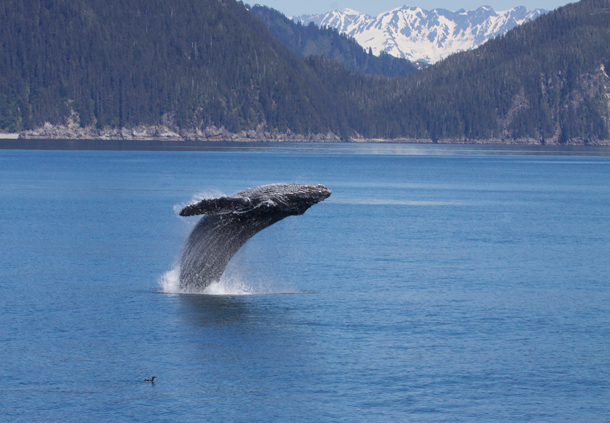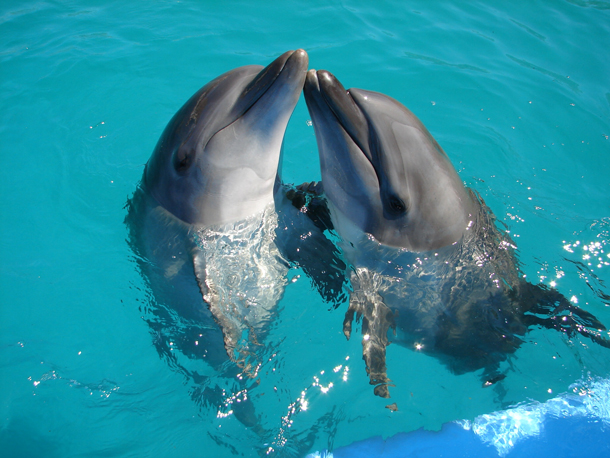The Law of Languages
Air Date: Week of May 31, 2019

Humpback whales are known for communicating through their low songs. (Photo: Gregory Smith, Flickr, CC BY-SA 2.0)
Every human language that’s been tested follows a similar pattern called Zipf’s law. Now researchers are looking to see if non-human languages like dolphins and whales follow a similar structure. Laurance Doyle from the SETI Institute tells Host Bobby Bascomb about some of his surprising results.
Transcript
BASCOMB: It’s Living on Earth. I’m Bobby Bascomb.
Human languages can sound so different; it may be hard to imagine that Chinese…
[PERSON SPEAKING CHINESE]
BASCOMB: … has anything in common with French…
[PERSON SPEAKING FRENCH]
BASCOMB: … Or Arabic…
[PERSON SPEAKING ARABIC]
BASCOMB: But back in 1945 George Zipf, a linguist, discovered every human language he studied all had at least one feature in common, which he named Zipf’s law. Zipf’s law states that the most common word in a given language is used exactly twice as frequently as the second most common word and three times more often than the third most common word and so on. So if you put each word on a graph, they all fit very neatly at a 45 degree slope. That got Laurance Doyle wondering if Zipf’s law can be applied to non-human languages. Laurance is an Astronomer for the SETI Institute, that’s the Search for Extraterrestrial Intelligence, but for this research Laurance began looking much closer to home, at the animals on our own planet. Laurance Doyle welcome to Living on Earth.
DOYLE: Thank you. Nice to be living here.
BASCOMB: [LAUGHS] Indeed. So what animals have you studied so far?
DOYLE: Our extensive study has squirrel monkeys, ground squirrels, bottlenose dolphins, humpback whales, and humans. Those are the ones I've been involved in. And I think I would have to guess there are at least a dozen other species that people are applying our, the information theory work to. And so we decided to start with bottlenose dolphins and humpback whales because they're intelligent, they're socially complex, they both use tools. But also they put most of their communication in audio. So unlike chimpanzees, we wouldn't have to try and interpret gestures or facials. So that's what I'm doing in Alaska with humpback whale recording.
BASCOMB: Does Zipf's law apply to humpbacks?
DOYLE: Yes. So far there are three kinds of humpback whale vocalizations. One is the singing that they do in Hawaii. And apparently, some recent investigation indicates that their vocalizations, their songs in Hawaii, they may be rhyming. What we want to do, though, is get their social calls and their feeding calls. And so we're up in Alaska where they're feeding, and building bubble nets and working together to catch herring and krill. And they are also very social, they're talking instead of, you might say, singing. We are still investigating humpback whale song, but as far as we know, their social calls obey Zipf's law, and their feeding calls don't.
BASCOMB: Oh, that's interesting.
DOYLE: Well, you know, it could be that the feeding call is like -- say you have a cowboy, and he's herding cows. And he's talking to his friend, he goes, 'I bought a new harmonica today, hya, hya, hya!' And you would say, okay, well, "hya" is a sound he's making along with the others, but it's a herding call. It's not a social vocalization. And = humpback whales make feeding calls, and they also have social vocalizations, and they may be different. And one of the things we found was if noise is introduced, you slow down the social communication, but you speed up the herding. So imagine a cowboy again. He's going, 'What did you say?’ ‘I bought a new harmonica,' or something like that. You'd slow down the vocalization. But you go 'Hya, hya hya, hya hya!' You'd make that, the herding call, more often. And that's what we found with humpback whales. What we think is a herding call speeds up in the presence of boat noise. And what we think are social calls slow down.
BASCOMB: So they just, they're trying to be heard.

Bottlenose dolphins have an detailed social network and communicate through distinct herding and social calls. (Photo: Chase Cheviron, Flickr, CC BY-NC 2.0)
DOYLE: Yes. We calculated the channel capacity with and without boat noise. And we could say, okay, the humpback whales need to slow down this much. And they only slowed down 60% of that much. Here you're going 'Now, wait a second, they're herding herring, and they're making nets of bubbles. And it's important they get the whole message. How can they do with only 60% of the message?'
BASCOMB: And what's the answer?
DOYLE: Well, the answer was after a week or so of thinking about this, I went to make a copy of a paper. And I got it back to my desk from down the hall, and realized that the copier was low on toner. So I started to fill in the missing words.
BASCOMB: Ahh.
DOYLE: And that's when I realized: aha, they must have something equivalent to grammar and syntax and spelling rules. Because they are filling in the difference. They're going, 'I get the gist of it.' And the only way they could say that is if there are rules. So we went looking for rules structure in humpback whale, and we found it.
BASCOMB: So it'd be like if I was sending a text message or a Twitter or something, and you don't want to include so many words, you can start to drop articles, you can drop "the" and "a" and "to" and people still understand.
DOYLE: Exactly. That's exactly it, because there are rules.
BASCOMB: Now what about dolphins? I understand that you've looked at dolphin communication as well. What did you find there?
DOYLE: We found that it obeys Zipf's law, and that the number of, you might say, phonemes in dolphin is similar to human languages. And we did find that the babies are born babbling and learn their language the same way humans do. Well, babies babbling do not obey Zipf's law. Instead of this 45-degree slope, theirs is much flatter. So we recorded two little baby dolphins, bottlenose dolphins were born at Marine World, and they landed on babbling. They did not obey Zipf's law until they were 20 months old. The distribution of their whistles landed exactly on the same slope that babies babble. And you expect baby babbling to not obey Zipf's law because they're making kind of random sounds, they're trying out a new language.
BASCOMB: Right.
DOYLE: But anyway, so we were able to mathematically prove that baby dolphins are born babbling. And they learn their whistle language the same way humans do.
BASCOMB: So all of this begs the question, I mean, if every human language and most animal languages -- or many, at least, animal languages -- all have this feature in common, what does that say about our shared evolutionary origin? Or is this simply a feature that works well for communication, so nature continues to select for it?

Laurance Doyle is an astronomer with SETI institute and President of PlanetQuest. (Photo: Courtesy of The SETI Institute)
DOYLE: It's like intelligence: if we have drawn a line about where intelligence starts, and some of the people that study intelligence, and in particular the origin and evolution of it, are beginning to see it as inseparable from the smallest critter to the largest critter. And we like to call that collective intelligence. But that's what we're expressing, too. We have no single individual, it's all kind of collective. And that requires inner communication. So I guess what I'm saying is there's a continuity of complexity in the communication systems of all the species on Earth, including, by the way, plants. I have a special paper I wrote on plant communicating with a, with an animal. A certain cotton plant sent an air traffic control communication to a wasp to tell it what plants to land on. And so I analyzed this communication system. So in other words, everything's around us communicating like crazy and I'm trying to get us not to stare up at the stars and say, 'Are we alone?' when you know, dolphins are tugging at our, our pants and saying, 'Habla espanol?' you know? --
BASCOMB: [LAUGHS]
DOYLE: -- 'Parlez-vous francais?' It's like, we've really got to quit staring off for intelligence. We need to recognize it here.
BASCOMB: Laurance Doyle is an astronomer for the SETI Institute and president of PlanetQuest. Thank you so much for your time.
DOYLE: You too. Thank you.
Links
Living on Earth wants to hear from you!
Living on Earth
62 Calef Highway, Suite 212
Lee, NH 03861
Telephone: 617-287-4121
E-mail: comments@loe.org
Newsletter [Click here]
Donate to Living on Earth!
Living on Earth is an independent media program and relies entirely on contributions from listeners and institutions supporting public service. Please donate now to preserve an independent environmental voice.
NewsletterLiving on Earth offers a weekly delivery of the show's rundown to your mailbox. Sign up for our newsletter today!
 Sailors For The Sea: Be the change you want to sea.
Sailors For The Sea: Be the change you want to sea.
 The Grantham Foundation for the Protection of the Environment: Committed to protecting and improving the health of the global environment.
The Grantham Foundation for the Protection of the Environment: Committed to protecting and improving the health of the global environment.
 Contribute to Living on Earth and receive, as our gift to you, an archival print of one of Mark Seth Lender's extraordinary wildlife photographs. Follow the link to see Mark's current collection of photographs.
Contribute to Living on Earth and receive, as our gift to you, an archival print of one of Mark Seth Lender's extraordinary wildlife photographs. Follow the link to see Mark's current collection of photographs.
 Buy a signed copy of Mark Seth Lender's book Smeagull the Seagull & support Living on Earth
Buy a signed copy of Mark Seth Lender's book Smeagull the Seagull & support Living on Earth

